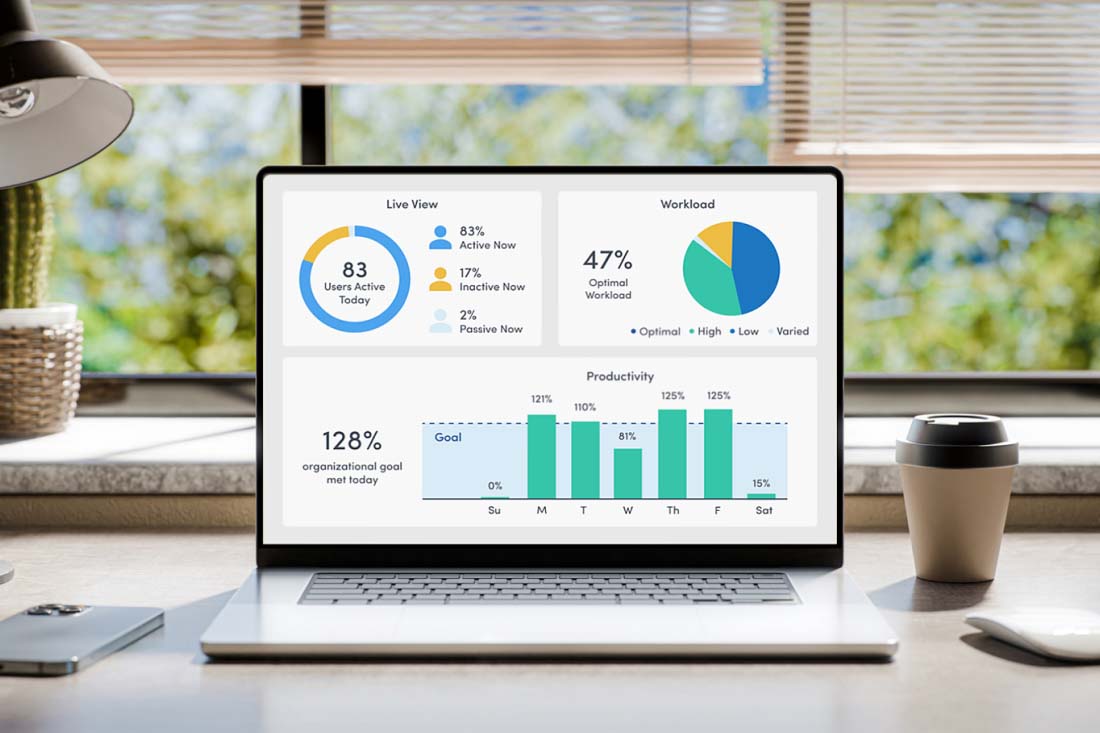Workforce analytics tools provide business leaders with visibility into employee and team productivity, process bottlenecks, and overall business intelligence. What started as an HR tool has now expanded across departments, allowing businesses to leverage workforce analytics and improve overall operations and productivity. This has proved incredibly valuable in today’s remote work landscape, where many companies have had to quickly shift to partial or full remote operations in response to the COVID-19 crisis. Workforce analytics can provide clearer visibility into how a business is operating, so companies still have a pulse on their workforce, regardless of remote factors.
To help you better understand how remote workforce analytics tools can help, we’re highlighting a few industry-leading solutions. Because workforce analytics is a quickly evolving category, we’ve hand-picked our favorites across four key areas: standard HR, HR with a twist, statistical analysis and visualization, and team management.
Standard HR Workforce Analytics Tools
Workforce analytics began as a tool specific to HR, and that use case still applies today. With HR workforce analytics, HR departments collect data on employees to understand and improve HR-related goals such as recruitment, retention, employee engagement, and training. Although workforce analytics is evolving beyond HR departments, traditional HR workforce analytics tools are still important for companies that rely on robust HR departments. Here are some of the industry-leading tools in this area:
An exciting new option on an old classic, Oracle HCM launched in 2011, and is a robust capital human management cloud solution that helps companies manage every stage of the employee lifecycle including talent acquisition, screening, hiring, onboarding, payroll, and compensation.
In May 2020, Oracle announced the availability of a tool to help companies get easier access to more robust data models and advanced analytics: Oracle Analytics for Cloud HCM. While this helps HR teams get deeper data, it does come with its downsides. Many users point out how slow and complicated the software is, and everyone seems to agree that you need a good amount of training to master its features.
Already a critical brand for many companies because of their ERP solutions, SAP also offers an effective and accessible SaaS workforce analytics tool: SuccessFactors. Offering a comprehensive library of 2,000+ standard HR metrics and benchmarks, organizations have access to benchmarks that serve as a guide. Data modeling and reporting is also pretty straight-forward and intuitive. Unsurprisingly, since SAP software usually targets enterprise companies, the tool is one of the more expensive options for what it offers.
Kronos offers a variety of workforce and human capital management solutions, but the one we’re highlighting is Kronos Analytics. Analytics specifically focuses on tracking and displaying workforce trends in real-time. Users get comprehensive reports, centralized dashboards, and useful data insights. Leveraging their HR expertise, they’re pushing much-needed tech and feature modernization in this area. But this is another tool that requires comprehensive training, and a complementary suite of products from Kronos to drive big workforce outcomes.
Modern HR Options (or HR with a Twist)
Along with standard, traditional HR platforms, certain tools offer a basic HR workforce setup, but also include options to take the data beyond an HR application. This can include either drilling deeper into a particular industry segment or the addition of closely-related feature functionality that can be leveraged by other departments. We love seeing this type of expansion; workforce analytics offer many uses outside of HR!
Many organizations prefer HR and workforce tools be tied to their specific industry. Calabrio is an expert in offering contact center tools that can improve visibility into productivity and overall operations. Their tools are also tailored for remote needs. Calabrio ONE offers standard HR workforce features including scheduling, engagement and performance management functionality, as well as contact center-specific features such as coaching and call recording. The collected data can also be combined into focused business intelligence for real-time insights and data visualization.
You might have already heard about Workday. They’re making quite the splash, and Gartner has selected them as leaders in Cloud Core Financial Management and Cloud Financial Planning. They offer a robust platform that offers all-in-one capabilities for finance, HR, and business planning.
Data from these three areas are aggregated into a streamlined workforce analytics resource. Companies can choose standalone products including Analytics and Reporting, but the technology works best when the entire suite is deployed together. Overall, the user interface is smart, but the graphics aren’t as robust and advanced options can be difficult to navigate.
Statistical Analysis and Visualization
Critical, but limited in scope, these workforce analytics tools are exclusively used for deep, heavy statistical analysis and visualization. Nothing is probably too surprising on this list–they’re gold standards for what they do.
First up is R. R is an open-source language and environment for statistical computation, data analysis, and graphics. It’s widely used by statisticians and data scientists alike. It’s a bit of a cheat on this list because it’s not a packaged tool like all the other ones we’ve discussed. But it’s critical enough to warrant a mention. R offers an extensive library to make database manipulation and wrangling easier and less time-consuming. It also offers valuable shortcuts for data visualization. This programming language has been so widely adopted both in academia and in business that it is already integrated into a lot of software mentioned below such as SQL Server, Azure SQL Database, Tableau, Power BI, and Visual Studio. Our best recommendation? If you know data analysis and visualization is critical to your business, make sure someone on your team is well-versed in R.
Tableau is another ubiquitous data visualization tool that can offer a lot of workforce analytics functionality. It specializes in transforming raw data (and importantly, massive quantities of raw data) into easy-to-understand data visualizations. Virtually any data can be visualized using this powerful tool, so its use cases for workforce analytics are almost endless. It’s not a tool for beginners, however, and requires an experienced Tableau practitioner to get the best results.
A direct competitor of Tableau, Microsoft Power BI offers similar features and functionality, but with a few core differences. If your company already relies heavily on Microsoft products like Azure, Office 365, and Excel, then this data visualization tool may be easier to implement. Additionally, while Tableau was created for data scientist users, Power BI is accessible to beginners. Matching other Microsoft products, the interface is intuitive and does not require extensive expertise to utilize.
Team Management
Business intelligence, data science, and analytics have become buzzwords as companies everywhere are rapidly trying to use data to drive better business decisions. With the dramatic increase in remote work, data has evolved from a “nice-to-have” to a “must have” aspect of business strategy and survival. The following unique remote workforce analytics tools are approachable, easy to incorporate, and provide clear benefits for workforce and productivity insights that can be used by any business professional.
This award-winning and industry leading collaboration and project management platform offers organization to remote projects and teams. Workloads can be managed appropriately, project timelines can be measured and tracked, and outcomes of a team or project’s efforts can be analyzed. While project management is the focus, businesses can also use Monday’s reporting features to get a high-level overview of how work is getting done, and incorporate this analysis into future decision-making.
Remote work is challenging without team collaboration and communication tools. Microsoft Teams (MS Teams) is a great solution to these challenges, especially if you’re using Microsoft 365. It provides comprehensive communication possibilities including chat, video conferencing, and document collaboration. The breadth this tool offers is powerful, and makes it easy to analyze communication and collaboration metrics.
Shameless plug, we know, but we’re industry experts in employee and productivity monitoring, and we’ve expanded our platform into a powerful remote workforce analytics tool. Unlike some tools on this list that focus on specialized use-cases, we take a high-level and accessible approach to workforce analytics. Our cloud-based user activity monitoring platform collects and analyzes data and provides insights via dashboards and reports that help organizations be more productive and operationally compliant. Our award-winning solution can be configured in minutes to provide visibility into employee productivity, identify operational bottlenecks, flag risks, and provide valuable data insights that improve business outcomes. Start your FREE account today by clicking here.
About ActivTrak
ActivTrak is a workforce productivity and analytics software company that helps teams understand how people work, whether in-office or remote. Our cloud-based user activity monitoring platform collects and analyzes data and provides insights to help organizations be more productive and compliant. With more than 8,000 customers and over 250,000 users of its free version, ActivTrak’s award-winning solution can be configured in minutes to identify operational bottlenecks, flag operational compliance risks, and provide valuable insights that help employees and employers improve productivity outcomes.





